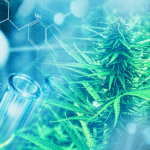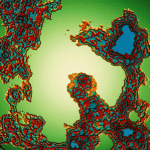When you cut yourself and start to heal, your body forms a matrix of tissue largely composed of collagen. It’s the basis of the scar tissue that forms where the cut was. For people with scleroderma, a rare auto-immune disease, their tissues continue developing even without an injury, resulting in the overproduction of collagen and other fibrous tissues, called fibroblasts, in the skin and internal organs.
People with scleroderma often experience pain and inflammation. As is the case with many autoimmune diseases, there aren’t any therapies that have been specifically developed to treat this condition. The scarcity of treatment options makes scleroderma an “orphan disease” – a special classification that the Food and Drug Administration (FDA) uses to incentivize drug-makers to develop new and innovative “orphan drugs” for the treatment of rare diseases.
Two compounds that target the endocannabinoid system are currently in development to treat scleroderma – and they’re already in clinical trials. Scleroderma patients are hoping that these efforts will prove to be as successful as Epidiolex, the cannabis-derived CBD pharmaceutical approved by the FDA in 2018 as an orphan drug for two forms of severe pediatric epilepsy (Lennox-Gastaut Syndrome and Dravet Syndrome).
What Is Scleroderma?
Degenerative autoimmune diseases are often poorly understood, and such is the case with scleroderma. Medical scientists don’t really know what causes it, or how to treat it. It’s theorized that both genetics and environmental factors can play a role in its development.
The earliest symptoms of scleroderma usually involve a thickening of the skin and a condition known as Raynaud’s phenomenon, which constricts the arteries and turns the fingers blue when they’re exposed to cold.
There are two primary types of scleroderma – localized scleroderma (morphea), which affects specific areas of the skin; and systemic scleroderma, a potentially fatal condition characterized by the thickening of tissues around organs. Systemic scleroderma can lead to excess collagen and scar tissue in the lungs (interstitial lung disease), resulting in the constriction and blockage of pulmonary arteries (pulmonary artery hypertension).1
The Endocannabinoid System & Scleroderma
Scleroderma usually appears at first as an abnormal skin condition. Skin diseases typically involve a dysregulation of the endocannabinoid system (ECS). This is true for scleroderma, as well as for more common maladies like acne and psoriasis.
Comprised of endogenous compounds that bind to cannabinoid receptors – CB1 and CB2 – that are expressed in all types of skin cells, the ECS plays a vital role in maintaining skin homeostasis through a signaling mechanism that promotes healthy skin renewal and barrier function.2
There are several reasons why the endocannabinoid system might present a good target for scleroderma drugs. Both cannabinoid receptors subtypes are overexpressed in scleroderma fibroblasts,3 as is the endogenous cannabinoid 2-AG.4
Additionally, the expression of FAAH, the metabolic enzyme that breaks down the endocannabinoid anandamide, is abnormally low in the skin of scleroderma patients. This indicates that something is fundamentally out of whack with the endocannabinoid system.5
THC & Fibrosis
In petri dishes and rodents, CB1 and CB2 receptors appear to play opposing roles in disease models of scleroderma. Activation of CB1 receptors actually promotes the growth of excess connective tissue.6 CB2 receptor activation, on the other hand, seems to limit that same growth. CB1 signaling in peripheral organs has a profibrotic effect (and also promotes wound healing); CB2 signaling has an antifibrotic (and blood-thinning) effect. A well-functioning endocannabinoid system maintains a balance between the pro and antifibrotic properties of CB1 and CB2.
Tetrahydrocannabinol (THC), the principal intoxicating component of cannabis, conveys therapeutic benefits by activating both cannabinoid receptor subtypes. When THC binds to CB1 receptors in the brain and central nervous system, it makes a person feel high and hungry, among many other effects. When THC binds to CB2 receptors on immune cells and in the peripheral nervous system, it eases pain and inflammation. THC can induce profibrogenic or antifibrogenic effects in the liver, where both cannabinoid receptor subtypes are present. So, too, in the skin.
WIN55,212, a synthetic cannabinoid compound that activates both CB1 and CB2, is commonly used instead of THC in experiments. Some scientists decided to see what WIN55 would do in a rodent model of scleroderma. They found that rodents treated with this synthetic cannabinoid developed less excess collagen and generally fared better compared to untreated animals.7
Would other compounds – such as THC – that bind to both cannabinoid receptors confer similar effects? Or would THC accentuate problematic tissue growth by activating CB1 receptors? Unfortunately, in the United States clinical trials involving THC have gotten short shrift because of marijuana prohibition, resulting in a paucity of data pertaining to scleroderma and many other conditions that might respond to cannabis-based therapies.
A single case study from Israel indicates that smoking cannabis helped to alleviate inflammatory pain and improve the quality of life of one young scleroderma patient.8 The condition of this cannabis smoker remained stable throughout observation, suggesting that consumption of THC at the very least didn’t have a harmful impact on his disease. But a chemical analysis was not performed on his stash, so we have no way of knowing the content of what he was actually consuming.
Clinical Trials for Cannabinoids
Given that CB1 receptor activation in preclinical research has been shown to promote excess tissue and collagen formation whereas CB2 receptor activation has the opposite effect, pharmaceutical researchers have their sights set on developing a drug that bypasses CB1 while boosting CB2. Referred to as a “selective CB2 agonist,” such a compound would appear to have potential as a treatment for scleroderma.
What’s more, CB2 receptors are localized primarily outside the brain and therefore are not responsible for mediating THC-induced intoxication. A drug that selectively targets CB2 receptors would not cause any of the psychoactive side effects associated with CB1 activation – and that’s a big plus in terms of getting FDA approval.
Incentivized by the potential of developing an orphan drug for scleroderma, a couple of companies are betting on selective CB2 agonists that are currently in clinical trials. Ajulemic acid (AJA), under the brand name Lenabasum, is in a Phase 3 trial. And an orally administered, partially synthetic cannabinoid derived from CBD called EHP-101 (formerly VCE-004.8) is pursuing Phase 1. Both of these compounds have been shown to mitigate the production of excess tissues in rodent models, and both are well tolerated in humans.
It remains to be seen whether these efforts will bear fruit. Although earlier attempts to develop synthetic CB2 agonists into effective therapeutic modalities came up short, the progress of current clinical trials is encouraging. But there’s no telling if or when these scleroderma drugs might go to market. Meanwhile, readily available whole plant remedies may already be a viable option for scleroderma patients in states where medical cannabis and adult use are legal.
What About CBD?
CBD-rich cannabis, which remains off-limits (with few exceptions) to medical researchers, has never been formally studied as a scleroderma treatment. But extensive preclinical investigations with molecular isolates suggest that cannabidiol could be helpful for a number of reasons.
In vivo studies indicate that CBD inhibits CB1 receptor signaling without completely blocking it. Imagine that CB1 operates like a dimmer switch – CBD turns it down but not entirely. In theory, this would impede tissue or collagen overproduction.
At the same time, CBD is a potent anti-inflammatory that augments CB2 receptor signaling, thereby boosting the antifibrogenic activity that’s sorely deficient in scleroderma patients. Scientists have yet to sort out exactly how CBD induces effects that are similar to CB2 activation without binding directly to the CB2 receptor.
But this much is known: CBD can differentially modulate CB1 and CB2 receptor signaling by down-regulating the former while amplifying the latter – a beneficial combination for treating scleroderma. CBD also holds promise as a remedy for several other disorders (including fatty liver disease, diabetes, heart disease, obesity, and metabolic syndrome) that are associated with overactive CB1 receptor signaling and inadequate CB2 stimulation.
Cannabinoid science suggests that scleroderma patients (and many others) could also benefit by increasing their dietary intake of ß-caryophyllene, a common botanical compound found in cannabis, bitter greens, and kitchen spices such as black pepper, oregano, and cinnamon. ß-caryophyllene, an aromatic terpene, selectively activates the CB2 receptor without activating CB1.9
Perhaps a CBD-rich cannabis remedy – a topical and/or an ingestible – with a robust terpene profile that includes a healthy dose of ß-caryophyllene would be worth a try for scleroderma patients. Those who are using cannabis to treat an autoimmune condition should make sure their doctor knows; high doses of CBD and other plant cannabinoids may interact with pharmaceutical meds. And keep Project CBD in the loop, as well. If you use cannabis for scleroderma, let us know how it goes.
Zoe Sigman is Project CBD’s Program Director. © Copyright, Project CBD. May not be reprinted without permission.
Footnotes
- Nicole Fett, Scleroderma: Nomenclature, etiology, pathogenesis, prognosis, and treatments: Facts and controversies, Clinics in Dermatology, Volume 31, Issue 4, 2013, Pages 432-437, https://doi.org/10.1016/j.clindermatol.2013.01.010.
- Tóth KF, Ádám D, Bíró T, Oláh A. Cannabinoid Signaling in the Skin: Therapeutic Potential of the “C(ut)annabinoid” System. Molecules. 2019;24(5):918. Published 2019 Mar 6. doi:10.3390/molecules24050918
- Garcia-Gonzalei E., et al. Cannabinoids inhibit fibrogenesis in diffuse systemic sclerosis fibroblasts, Rheumatology, Volume 48, Issue 9, September 2009, Pages 1050–1056, https://doi.org/10.1093/rheumatology/kep189
- Fernández-Ochoa Á., et al. Urinary and plasma metabolite differences detected by HPLC–ESI–QTOF–MS in systemic sclerosis patients. J. Pharm. Biomed. Anal. 2019;162:82–90. doi: 10.1016/j.jpba.2018.09.021.
- Palumbo-Zerr K., et al. Inactivation of fatty acid amide hydrolase exacerbates experimental fibrosis by enhanced endocannabinoid-mediated activation of CB1. Ann. Rheum. Dis. 2012;71:2051–2054. doi: 10.1136/annrheumdis-2012-201823
- Palumbo-Zerr K, Horn A, Distler A, et al. Inactivation of fatty acid amide hydrolase exacerbates experimental fibrosis by enhanced endocannabinoid-mediated activation of CB1. Annals of the Rheumatic Diseases 2012;71:2051-2054.
- Servettaz A, Kavian N, Nicco C, et al. Targeting the cannabinoid pathway limits the development of fibrosis and autoimmunity in a mouse model of systemic sclerosis. Am J Pathol. 2010;177(1):187–196. doi:10.2353/ajpath.2010.090763
- Nogueira, A. et al. Cannabis sativa as a Potential Treatment for Systemic Sclerosis. Israel Medical Association Journal, 2019 Mar;21(3):217-218. https://www.ncbi.nlm.nih.gov/pubmed/30905111
- Gertsch J, Leonti M, Raduner S, et al. Beta-caryophyllene is a dietary cannabinoid. Proc Natl Acad Sci U S A. 2008;105(26):9099–9104. doi:10.1073/pnas.0803601105







